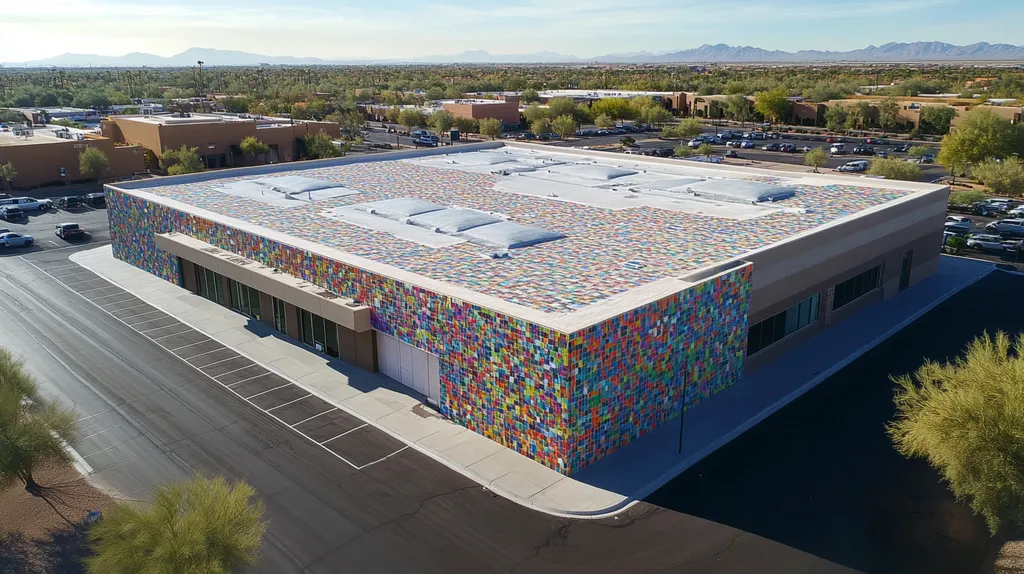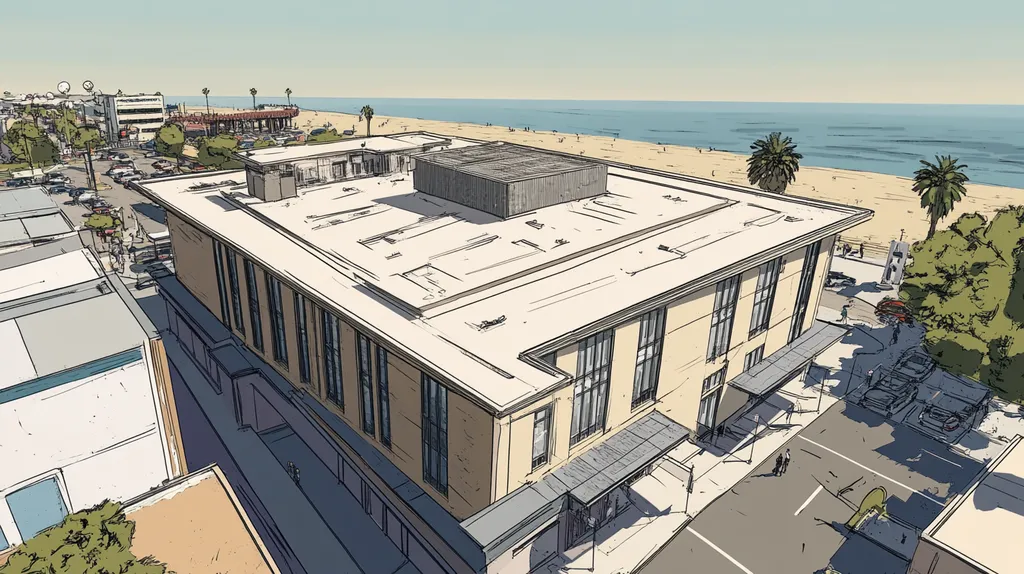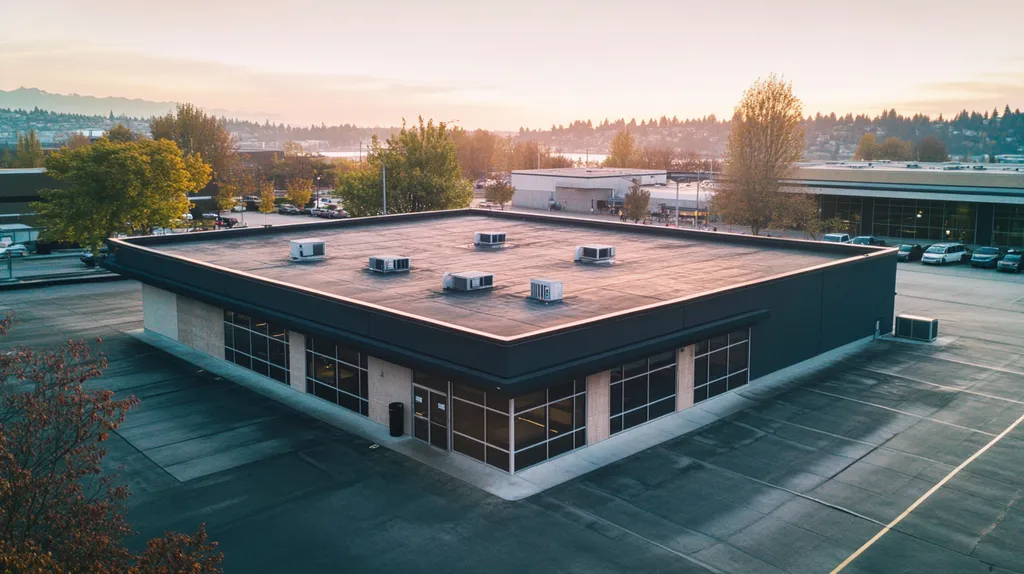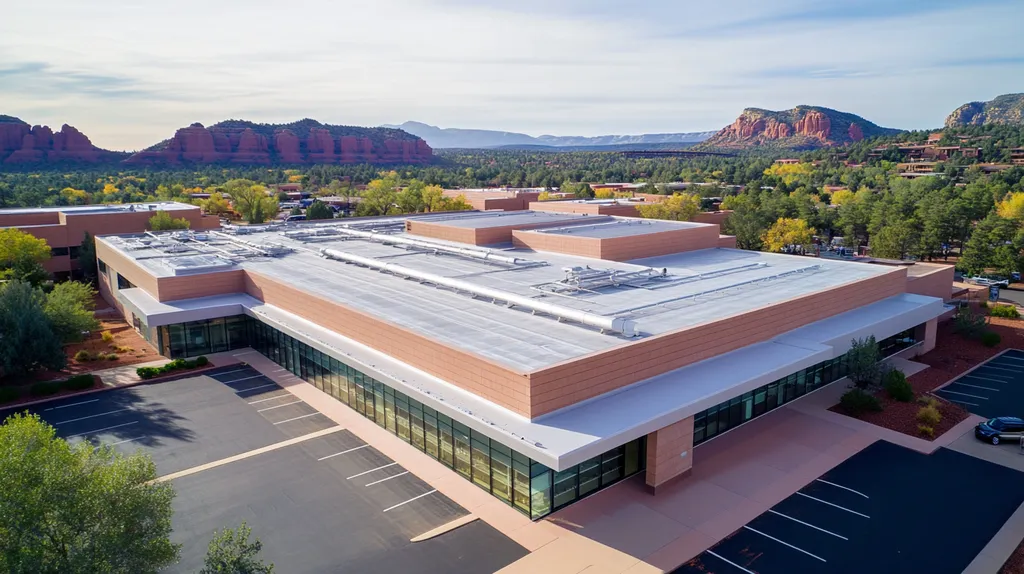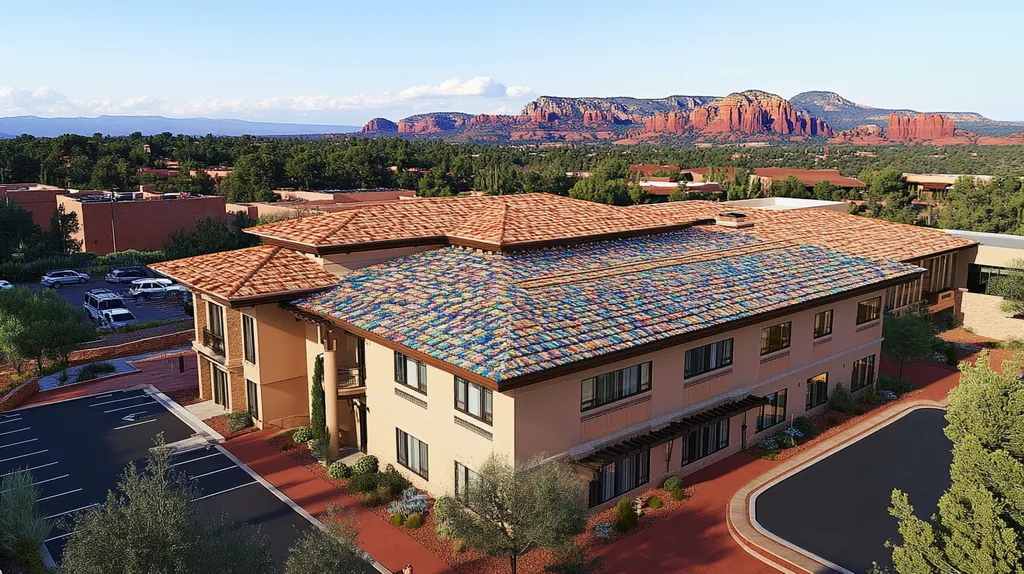Water damage from roof leaks costs U.S. businesses over $5 billion annually in repairs and lost productivity, yet many facility managers overlook the critical role of advanced waterproofing coatings in preventing these losses.
Modern coating technologies can extend roof life by up to 25 years while reducing energy costs by 30%, making them a vital investment for protecting commercial properties.
This comprehensive guide examines coating selection, application methods, compliance requirements, and maintenance protocols to help facility managers implement effective waterproofing solutions that safeguard their buildings and bottom line.
SECTION 1: PERFORMANCE FACTORS
The waterproofing performance of commercial roofs is vital for protecting the building’s integrity and controlling long-term expenses. When leaks occur, they can trigger not just structural damage but also mold growth and higher energy bills. Alarmingly, research by the National Roofing Contractors Association indicates that nearly 90% of roofing failures stem from inadequate waterproofing. By understanding the key performance factors related to coating systems, facility managers can make knowledgeable choices that boost the lifespan and efficiency of their roofs.
Coating Material Selection
The selection of the right coating material is crucial for effective waterproofing. Popular choices like acrylic, silicone, and urethane each offer unique advantages. For instance, silicone coatings are well-known for their excellent water resistance and UV stability, making them particularly suitable for flat roofs in extreme climates.
Acrylic coatings are breathable and help prevent moisture buildup, although they might struggle in areas prone to ponding water. Therefore, it’s essential for facility managers to evaluate the specific conditions of their roofs and choose a coating that best fits those needs.
Moreover, mismatching coating materials with the roof surface can lead to significant performance issues. A thorough examination of existing roofing conditions is necessary to ensure effective material selection.
Key Action Items
Durability and Flexibility
Durability and flexibility are vital characteristics influencing a coating’s capacity to endure various stresses. Roofs commonly undergo movement due to temperature fluctuations and structural settling, which can lead to cracks if the coating isn’t flexible enough.
High-quality coatings are engineered to expand and contract while maintaining their adhesion and structural integrity. For example, urethane coatings are recognized for their remarkable resilience, adapting well to the conditions encountered in commercial roofing.
The expected lifespan of a coating is equally important. Coatings with robust durability can minimize the need for frequent recoating, saving both time and money. Key durability attributes include UV resistance and chemical composition, which facility managers should prioritize in their selection process.
Key Action Items
Weather Resistance
Weather resistance is a critical feature that impacts the efficacy of waterproof coatings. Coatings must be able to withstand a range of environmental elements, such as rain, snow, extreme sun exposure, and varying temperatures.
Products specifically designed for harsh weather conditions, like reflective coatings, can enhance energy efficiency by minimizing heat absorption. This not only helps in safeguarding roofing materials but also significantly reduces cooling costs.
Additionally, the right coatings can resist moisture infiltration and mitigate damage from freeze-thaw cycles. When selecting a coating system, it’s essential to consider local climate conditions to ensure optimal performance throughout the year.
Key Action Items
SECTION 2: FINANCIAL CONSIDERATIONS
Facility managers are continually challenged to make sound financial decisions regarding commercial roofing. With average roofing replacement costs ranging from $5 to $10 per square foot, the financial implications are significant. Investing in waterproofing coatings can be a smart and cost-effective alternative to costly repairs or replacements. This section breaks down initial investment costs, long-term maintenance savings, and energy efficiency benefits associated with advanced waterproofing solutions.
Initial Investment Costs
The initial costs for high-quality waterproofing coatings can vary widely. Depending on the material and application method, facility managers can expect to invest between $1 to $3 per square foot. While this upfront cost might raise eyebrows, it’s essential to view this as a long-term investment rather than an immediate expense.
Facility managers often underestimate coating options due to their perceived costs. However, opting for a superior coating system can significantly extend the roof’s lifespan, resulting in fewer leaks and less frequent repairs over time.
Many manufacturers offer warranties that add value to these investments, promising enhanced resistance to environmental effects. Effective maintenance can further prolong the life cycle of the roof, leading to reduced replacement and repair expenses down the line.
Long-Term Maintenance Savings
One of the primary advantages of waterproofing coatings is the long-term savings associated with maintenance. Facilities that invest in these coatings often find they experience dramatically fewer maintenance issues. For example, roofs without proper waterproofing may need repairs every few years, whereas coated roofs can frequently last a decade or more with minimal intervention.
As leaks develop, maintenance costs can escalate rapidly. On average, annual roofing maintenance can reach 10% of a roof’s replacement cost. By investing in effective waterproofing solutions, facility managers can avoid unnecessary expenses and redirect those funds towards other critical areas.
A well-maintained coated roof can withstand harsh weather conditions better, leading to fewer service calls and a more stable maintenance budget over time. In essence, investing strategically in waterproofing coatings is not only preventative but also serves as a strong financial strategy for increased operational efficiency.
Energy Efficiency Benefits
Energy efficiency plays a crucial role in modern facility management. Waterproofing coatings, especially reflective types, greatly reduce solar heat absorption. Buildings fitted with these coatings often see a noticeable dip in cooling energy costs, with studies suggesting potential annual savings of up to 20% on energy bills.
As HVAC systems grow more efficient, the necessary demand for energy diminishes. Protecting the roof with effective waterproof coatings ensures a stable indoor temperature, reducing strain on HVAC systems. This leads to longer lifespans for those systems and lower overall operating costs.
Moreover, energy-efficient roofs align with sustainability goals. By adopting environmentally friendly roofing solutions, facilities can not only bolster their reputation but may also benefit from energy rebates or tax incentives. Investing in waterproofing coatings significantly enhances roof longevity while contributing to energy efficiency and substantial cost savings—a strong return on investment.
SECTION 3: COMPLIANCE REQUIREMENTS
Compliance with roofing regulations is crucial for maintaining both the integrity of a facility and the safety of its occupants. Adhering to established standards ensures that waterproofing solutions, like coatings, perform effectively and sustainably. Neglecting these regulations can lead to hefty fines, damaged reputations, and unsafe conditions. This section will highlight the key regulatory standards, environmental compliance, and building code adherence necessary for successful waterproofing practices.
Regulatory Standards
Regulatory standards dictate the materials and methods permissible in commercial roofing systems, which can vary significantly by region. Facility managers must conduct diligent research to understand these ever-evolving regulations. For instance, the Environmental Protection Agency (EPA) enforces guidelines on the chemicals used in roofing materials, and non-compliance can result in steep penalties and mandatory retrofitting.
Standards from organizations like the American Society for Testing and Materials (ASTM) set benchmarks for product performance, including adhesion, elasticity, and weathering resistance. By keeping up with regulatory developments, property owners can prevent costly violations and ensure their roofing systems are resilient against environmental challenges.
Focusing on compliance not only shields facilities from legal ramifications but also enhances overall building performance. It ensures that roofing systems can withstand daily weather exposure, thereby extending their lifespan. Facility managers are encouraged to collaborate with experienced roofing contractors who are well-versed in compliance, helping to streamline waterproofing solutions that meet all the necessary regulations.
Key Action Items
Environmental Compliance
As sustainability increasingly becomes a priority in the construction sector, environmental compliance has gained prominence. Many roofing coatings contain volatile organic compounds (VOCs), which pose environmental and health risks. Regulations are in place to limit VOC levels in roofing products, prompting facility managers to seek eco-friendly alternatives.
Choosing environmentally friendly coatings not only reduces a facility’s carbon footprint but also fulfills waterproofing needs. Water-based coatings often meet strict environmental standards while delivering excellent waterproofing without harmful emissions. Selecting low-VOC options ensures compliance and positions a company as a leader in sustainability.
Furthermore, coatings that adhere to environmental regulations are recognized by the U.S. Green Building Council (USGBC) for LEED certification, which can result in financial perks and increased building value. Keeping environmental compliance at the forefront when selecting waterproofing coatings leads to enhanced facility performance and a positive environmental impact.
Key Action Items
Building Code Adherence
Building codes establish the essential safety and performance standards for roof systems, influencing the choice of design and materials. Compliance is critical for ensuring that roofing systems can endure local environmental conditions. Certain building codes may specify the necessary wind uplift resistance for roofs, which varies by geographical area.
Selecting waterproofing coatings that align with building code standards enhances durability and safety. Failing to meet these codes can lead to failed inspections, costly project delays, and increased liability for facility managers. Therefore, understanding local building codes is vital when choosing coatings for roofs.
In addition to safety, building codes often address effective drainage and water management, crucial elements for reliable waterproofing. Proper drainage reduces the likelihood of water pooling, enhancing the longevity of roofing systems. By ensuring all coatings support efficient drainage in compliance with codes, facility managers can significantly reduce the risks of water damage.
Key Action Items
SECTION 4: RISK MANAGEMENT
In the world of commercial roofing, the potential consequences of neglecting maintenance can be significant. A single leak not only risks extensive damage but also brings financial burdens and legal ramifications. Studies reveal that nearly 30% of roofing-related lawsuits stem from water infiltration, underscoring the need for proactive risk management strategies that protect investments. This section delves into essential strategies for leak prevention, outlines damage mitigation plans, and explains the critical role of insurance.
Leak Prevention Strategies
Preventing leaks is essential for safeguarding commercial roofs against moisture-related damage. Facility managers should conduct regular inspections at least twice a year to identify vulnerabilities such as cracks or faulty seams and address them promptly.
High-quality waterproofing coatings can greatly enhance a roof’s resistance to water intrusion. These coatings create an impermeable barrier that protects against leaks and can significantly extend the roof’s useful life.
Another critical component is maintaining effective drainage systems. Blocked gutters can cause water accumulation, which increases leak risks. Regular cleaning and maintenance of these systems are vital.
Investing in employee training on roofing systems is also beneficial. Well-informed staff can spot potential issues early, preventing costly leak incidents down the road.
Key Action Items
Damage Mitigation Plans
Even with proactive measures, unforeseen incidents can still happen. Implementing a damage mitigation plan is crucial for minimizing their impacts. Facility managers should develop a detailed action plan that specifies immediate steps for addressing water infiltration.
This plan should include a comprehensive list of emergency contacts, including roofing contractors and water damage restoration specialists. Quick access to these resources can help limit damage and expedite repairs.
Utilizing moisture detection systems is another effective strategy. These technologies can provide early alerts to leaks, enabling prompt action that can minimize repair costs.
Regular updates and reviews of the mitigation plan are essential to its effectiveness. Conducting drills can help familiarize staff with the procedures, enhancing their response during actual incidents.
Key Action Items
Insurance and Liability
Understanding insurance coverage is an integral component of effective risk management. Many facility managers overlook the fine details of their policies, which could result in inadequate protection during roofing failures. Conducting an insurance audit is vital to clarify coverage related to roof damage and associated liabilities.
Managers should prioritize comprehensive policies that cover both damages from leaks and potential legal liabilities. Taking this proactive approach not only protects financial interests but also enhances peace of mind.
Including waterproofing coatings in maintenance records can help secure lower insurance rates, as insurers often reward preventative measures that minimize property risks.
Staying updated on local building codes is equally essential. Non-compliance can lead to fines, increased liability, and complications when filing insurance claims after water incidents.
Key Action Items
SECTION 5: OPERATIONAL PROCEDURES
Successful waterproofing of commercial roofs hinges on robust operational procedures. The financial stakes are high; inadequate maintenance can lead to significant water damage, resulting in millions spent on repairs annually. Studies indicate that poor maintenance practices can elevate roof replacement costs by as much as 30%. This section covers essential steps in the application and installation of coatings, regular inspection protocols, and maintaining effective repair and maintenance schedules.
Application and Installation
The application and installation of waterproofing coatings are critical to ensuring they perform effectively over time. It is essential that trained professionals carry out this process, meticulously adhering to the manufacturer’s guidelines. This includes selecting appropriate primers and ensuring ideal environmental conditions—such as temperature and humidity—during the application.
High-quality materials enhance waterproofing effectiveness significantly. For instance, elastomeric coatings can stretch up to 300% to accommodate temperature fluctuations, providing a resilient barrier against water intrusion. Properly allowing each layer to cure before applying others prevents premature failures in the coating system.
Documenting the application process with photographs and receipts not only aids in future warranty claims but also helps facility managers track the roofing system’s lifecycle effectively. Moreover, regular training for the personnel involved ensures adherence to best practices and preparedness for any challenges that may arise during installation.
Key Action Items
Regular Inspection Protocols
Establishing regular inspection protocols is vital to preserving the integrity of waterproofing coatings. Inspections should occur at least twice a year, ideally in spring and fall, to align with seasonal changes that may impact the roof’s condition. Having trained personnel identify potential issues early can significantly reduce long-term repair costs.
During inspections, focus on vulnerable areas such as seams, laps, and ventilation penetrations, which are often the weakest points and most likely to suffer leaks. Visual assessments should be supplemented with moisture detection tools to identify hidden water issues.
An organized inspection checklist enhances the process’s consistency by itemizing all components being examined and allowing detailed notes on deficiencies. Post-inspection reports are essential for managing necessary repairs proactively, ensuring the facility remains operational without unexpected interruptions.
Key Action Items
Repair and Maintenance Schedules
Establishing a thorough repair and maintenance schedule is essential for maintaining the waterproofing effectiveness of commercial roofs. Addressing issues swiftly can prevent minor damage from escalating into significant structural failures. Following routine inspections, operators should prioritize necessary repairs based on severity.
A well-defined maintenance cycle—typically annually or semi-annually—should include tasks like cleaning roof surfaces, assessing drainage systems, and resealing worn areas. Regular adherence to this schedule can notably extend the life of roofing materials.
Engaging qualified roofing contractors can facilitate an efficient repair process, ensuring all work meets safety and regulatory standards. Using technology, like maintenance management software, can simplify scheduling and documentation, providing transparency regarding the roof’s condition and maintenance expenditures.
Key Action Items
SECTION 5: OPERATIONAL PROCEDURES
Effective waterproofing for commercial roofs relies heavily on solid operational procedures. The stakes are high; without proper maintenance, roofs can succumb to significant water damage, resulting in millions in repairs every year. Industry studies reveal that insufficient maintenance practices can increase roof replacement costs by up to 30%. This section will detail the vital phases of application and installation, inspecting the integrity of the coatings, and creating timely repair schedules.
Application and Installation
The application and installation of waterproofing coatings are crucial for securing long-term performance. Trained professionals should handle these tasks, following the manufacturer’s specifications to the letter. This includes choosing the appropriate primer and ensuring the environmental conditions, such as temperature and humidity, are optimal during the application process.
Utilizing high-quality materials can greatly enhance waterproofing effectiveness. For example, elastomeric coatings can stretch significantly—up to 300% of their original size—making them ideal for accommodating temperature changes while providing a reliable water barrier (source: American WeatherStar). Additionally, allowing each layer to cure properly before applying the next prevents premature failures.
Documenting the application process with photographs and receipts establishes a valuable reference for future management. This practice is advantageous for warranty claims and helps facility managers keep track of the roofing system’s lifecycle.
Regular training for personnel involved in these procedures helps ensure adherence to best practices, empowering teams to address challenges that may arise during installation effectively.
Key Action Items
Regular Inspection Protocols
Establishing regular inspection protocols is essential for preserving the integrity of waterproofing coatings. Inspections should take place at least twice a year, ideally in spring and fall, aligning with seasonal changes that could impact the roof’s condition. This proactive approach enables trained personnel to identify potential issues before they escalate.
During inspections, focus on critical areas such as seams, laps, and ventilation penetrations, as these locations are often the weakest points and most prone to leaks. Supplementing visual checks with moisture detection tools can uncover hidden water presence that might go unnoticed.
An organized inspection checklist enhances consistency, allowing for detailed notes on observed deficiencies. Maintaining historical data from past inspections aids in identifying trends over time, providing valuable insights into the roof’s condition.
After each inspection, generating a report outlining findings and suggested actions is crucial for proactive management of necessary repairs, helping to minimize any unexpected downtime for the facility.
Key Action Items
Repair and Maintenance Schedules
Creating a thorough repair and maintenance schedule is vital for sustaining the waterproofing effectiveness of commercial roofs. Timely repairs can prevent minor issues from developing into significant structural failures. Operators should prioritize necessary repairs based on the severity of findings from routine inspections.
Establishing a maintenance cycle—typically annually or semi-annually—ensures ongoing roof performance. This cycle should encompass tasks like cleaning the roof surface, checking drainage systems, and resealing worn-out areas. Consistency in this maintenance regimen significantly extends the life of roofing systems.
Engaging qualified roofing contractors facilitates an efficient repair process, ensuring that all work complies with safety standards and local regulations. By utilizing technology such as maintenance management software, scheduling and documentation become simplified, providing clear insights into the roof’s condition and associated maintenance costs.
Key Action Items
Looking Ahead
With water damage costing U.S. businesses over $5 billion annually, implementing effective waterproofing solutions is no longer optional for facility managers.
Modern coating technologies have revolutionized commercial roofing, offering up to 25 years of protection while reducing energy costs by 30%.
Success requires a strategic approach incorporating proper material selection, professional application, rigorous maintenance protocols, and regulatory compliance.
By following the action items outlined in this guide, facility managers can transform their roofing systems from potential liabilities into valuable assets that enhance building performance and protect the bottom line.
The future of commercial roofing lies in proactive waterproofing strategies that combine durability, sustainability, and cost-effectiveness.
FREQUENTLY ASKED QUESTIONS
Q. What performance factors affect a commercial roof’s waterproofing?
A. The waterproofing performance of commercial roofs depends on coating material selection, durability, and weather resistance. Choosing the right coating helps prevent leaks, mold growth, and energy costs. High-quality materials ensure longevity and effective drainage, ultimately protecting the building’s integrity.
Q. How do financial considerations impact commercial roofing decisions?
A. Initial investment costs in waterproofing coatings can lead to long-term savings. Although these coatings may have a higher upfront cost, they significantly reduce maintenance and replacement expenses. Investing in roofing solutions ultimately protects budgets and enhances overall operational efficiency.
Q. What compliance requirements should facility managers consider for roofs?
A. Facility managers must stay updated on local roofing regulations, environmental compliance, and building codes. Adhering to these guidelines ensures safety and effective performance. Prioritizing compliance helps avoid penalties and enhances the overall quality of the roofing system’s waterproofing.
Q. How can risk management strategies help protect commercial roofs?
A. Implementing proactive leak prevention strategies and damage mitigation plans minimizes risks associated with water infiltration. Regular inspections and employee training foster awareness of potential issues. Additionally, understanding insurance coverage ensures facility managers are protected against financial losses effectively.
Q. What essential operational procedures improve waterproofing?
A. Successful waterproofing depends on proper application, regular inspections, and timely maintenance. Ensuring trained personnel apply coatings according to guidelines enhances effectiveness. Routine inspections identify issues early, while a well-defined maintenance schedule prevents minor problems from escalating, safeguarding investments in roofing systems.
Q. What technologies can improve commercial roof maintenance?
A. Utilizing technologies like moisture detection systems and maintenance management software improves roof maintenance efficacy. These tools provide real-time insights into roof conditions, streamline scheduling, and facilitate thorough documentation. Adopting such technologies enhances operational efficiency and prolongs roofing system longevity.
Q. How do energy-efficient coatings benefit commercial roofs?
A. Energy-efficient coatings reduce solar heat absorption, resulting in lower cooling costs for facilities. By maintaining stable indoor temperatures, these coatings ease strain on HVAC systems, extending their life and promoting sustainability. Overall, they contribute significantly to energy savings and lower operational costs.

